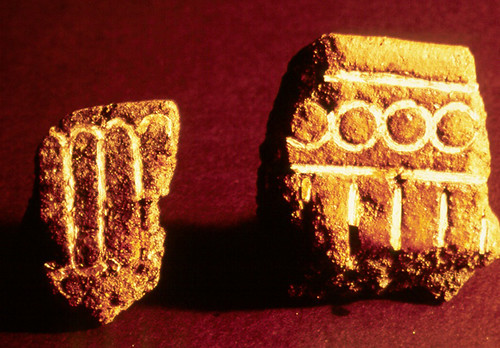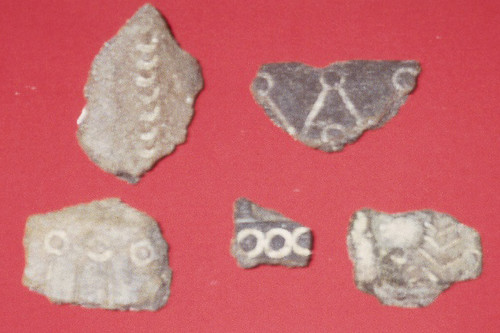Many pots decorated with lime
Of the different pottery forms produced in the Marianas, the lime-incised pottery from the early Pre-Latte era is of particular significance. Once referred to as Marianas redware, this early pottery is characterized as a thin-walled vessel with a red slip, or coated surface. The name redware has since been replaced by the term Early Calcareous Ware (EWC) because while these pots are made with a coral sand (calcareous) temper (a material mixed with the clay to make it more easily workable) not all vessels have the red slip.
The vessels are small to medium-sized, with “an in-slanting neck and an everted rim.” In addition, the surface of some ECW pottery may have finely incised designs filled with lime (afok). The designs vary, but may include lines or curvilinear patterns, along with punctate patterns or indentations.
The designs on ECW pottery resemble pottery from the Philippines produced around the same time—as early 1500 BC — however, there is no evidence to definitely link ECW pottery with similar pottery from the Philippines or Island Southeast Asia. Nevertheless, EWC pottery, along with linguistic evidence, is often used to demonstrate the links the ancient inhabitants of the Mariana Islands had with other Austronesian populations that migrated from Asia into the Pacific Ocean.
For further reading
Commonwealth of the Northern Mariana Islands Division of Historic Preservation. Tiempon I Manmofo’na. Ancient Chamorro Culture and History of the Northern Mariana Islands. By Scott Russell. Micronesian Archaeological Survey No. 32. Saipan: CNMIHPO, 1998.
Cunningham, Lawrence J. Ancient Chamorro Society. Honolulu: Bess Press, 1992.
Moore, Darlene R. “Measuring Change in Marianas Pottery: The Sequence of Pottery Production at Tarague, Guam.” MA thesis, University of Guam, 1983.
–––. “Pre-Historic Pottery of Guam.” in Guampedia, last modified 20 May 2021.





